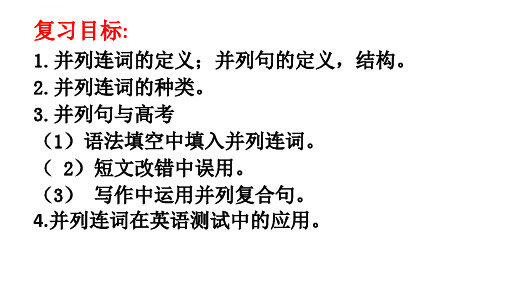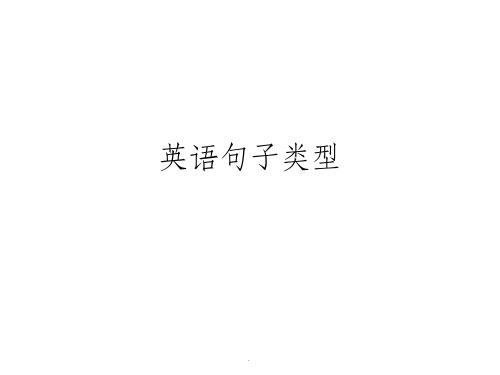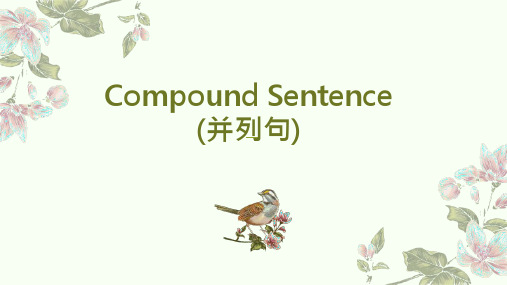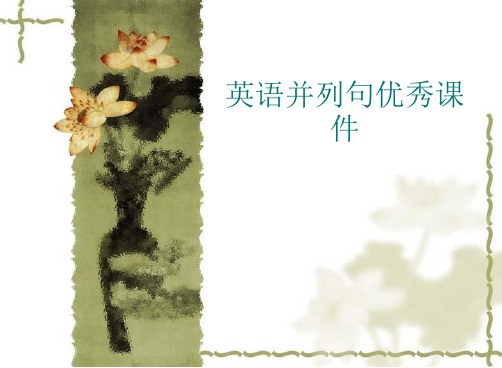高中英语基础并列句(好)ppt课件
合集下载
并列句与并列连词复习ppt课件

并列句与高考
改错
(2014全国)1. Although we allow tomato plants to grow in the
same place year after year, but we have never had any disease or
insect attack problems .
stolen.
2. There are few new words in the article, but we couldn't
understand it.
3. Hurry up, or you’ll be late.
4. It's raining very hard, so we'd better stay here.
并列句与高考
语法填空
(2014全国)1. But river wasn’t changed in a few days___o_r
even a few months.
在否定句中表示并列,用or。
为了规范事业单位聘用关系,建立和 完善适 应社会 主义市 场经济 体制的 事业单 位工作 人员聘 用制度 ,保障 用人单 位和职 工的合 法权益
为了规范事业单位聘用关系,建立和 完善适 应社会 主义市 场经济 体制的 事业单 位工作 人员聘 用制度 ,保障 用人单 位和职 工的合 法权益
复习目标:
1.并列连词的定义;并列句的定义,结构。 2.并列连词的种类。 3.并列句与高考 (1)语法填空中填入并列连词。 ( 2)短文改错中误用。 (3) 写作中运用并列复合句。 4.并列连词在英语测试中的应用。
简单句:只有 一个主谓结构
为了规范事业单位聘用关系,建立和 完善适 应社会 主义市 场经济 体制的 事业单 位工作 人员聘 用制度 ,保障 用人单 位和职 工的合 法权益
改错
(2014全国)1. Although we allow tomato plants to grow in the
same place year after year, but we have never had any disease or
insect attack problems .
stolen.
2. There are few new words in the article, but we couldn't
understand it.
3. Hurry up, or you’ll be late.
4. It's raining very hard, so we'd better stay here.
并列句与高考
语法填空
(2014全国)1. But river wasn’t changed in a few days___o_r
even a few months.
在否定句中表示并列,用or。
为了规范事业单位聘用关系,建立和 完善适 应社会 主义市 场经济 体制的 事业单 位工作 人员聘 用制度 ,保障 用人单 位和职 工的合 法权益
为了规范事业单位聘用关系,建立和 完善适 应社会 主义市 场经济 体制的 事业单 位工作 人员聘 用制度 ,保障 用人单 位和职 工的合 法权益
复习目标:
1.并列连词的定义;并列句的定义,结构。 2.并列连词的种类。 3.并列句与高考 (1)语法填空中填入并列连词。 ( 2)短文改错中误用。 (3) 写作中运用并列复合句。 4.并列连词在英语测试中的应用。
简单句:只有 一个主谓结构
为了规范事业单位聘用关系,建立和 完善适 应社会 主义市 场经济 体制的 事业单 位工作 人员聘 用制度 ,保障 用人单 位和职 工的合 法权益
高中基础语法知识--英语句子种类 共14张PPT

二、 委婉陈述人们在陈述事实的时候,为了礼貌或者为了在说话时留有余地,常常在说话时采用委婉陈述方 be, I think, too much for him. 我想那会使他受不了的。
(二)采用情态动词或半助动词来软化口气 He might be right. 他也许是对的。 She seems to be unhappy. 她似乎不快活。
Don't let him go. / Let him not go. 别让他走。
感叹句: what和how引导的感叹句
一、由感叹词what引导的感叹句。(修饰名词) 1.What+a/an+(形容词)+单数可数名词+主语+谓语!
如: What a fine day it is! 2. What+(形容词)+可数名词复数或不可数名词+主语+谓语!
疑问句: 分为一般疑问句和特殊疑问句
一般疑问句:be动词/助动词/情态动词开头的疑问句。 回答:yes/no。 特殊疑问句:特殊疑问词+一般疑问句。 回答:根据相关的句子意思进行相应的回答即可。
将陈述句变为 一般疑问句
1.带be动词的陈述句: she is a student 注意:I am a student
2.表转折关系的 but, however,while,still, yet The film is not perfect,still,it's good.
3.表选择关系的 or, either...or..., not...but... Take the chance,or you will regret it.
英语中千变万化的句子归根结底都是由以上五种基本句型组合、扩展、变化而来的
(二)采用情态动词或半助动词来软化口气 He might be right. 他也许是对的。 She seems to be unhappy. 她似乎不快活。
Don't let him go. / Let him not go. 别让他走。
感叹句: what和how引导的感叹句
一、由感叹词what引导的感叹句。(修饰名词) 1.What+a/an+(形容词)+单数可数名词+主语+谓语!
如: What a fine day it is! 2. What+(形容词)+可数名词复数或不可数名词+主语+谓语!
疑问句: 分为一般疑问句和特殊疑问句
一般疑问句:be动词/助动词/情态动词开头的疑问句。 回答:yes/no。 特殊疑问句:特殊疑问词+一般疑问句。 回答:根据相关的句子意思进行相应的回答即可。
将陈述句变为 一般疑问句
1.带be动词的陈述句: she is a student 注意:I am a student
2.表转折关系的 but, however,while,still, yet The film is not perfect,still,it's good.
3.表选择关系的 or, either...or..., not...but... Take the chance,or you will regret it.
英语中千变万化的句子归根结底都是由以上五种基本句型组合、扩展、变化而来的
高考英语语法专题复习课件-简单句和并列句

she
D. No,isn’t
• 9. —— ____A__ to be a PLA soldier when I was young.
• —— And now you are.
•
A. How I wanted
want
B. How did I
•
C. What I wanted
D. What did I want
•
C. How about
D. What if
B
• 5. —— You ought to stay up late tonight,__ __ you?
• —— Yes. I’ve got too much homework.
•
A. can’t
B. shouldn’t
•
C. mustn’t
D. won’t
•
more quickly and better.
•
AB. Giving B. Give C. Given D. To give
• 3. —— Lucy, you wash the dishes,___ ?
• —— Mom, can’t Lily do it? It’s her turn to do it.
演讲完毕,感谢观 看
单击此处添加副标题
简单句 (simple sentence)
只包含一个主谓结构Mary opened the d o o r.
两个主语和一个谓语Steve and his friend are coming to dinner.
一个主语和两个谓语Mary opened the door and greeted the guests.
(4) 主语+及物动词+间接宾语+直接宾语 (S+V+IO+DO)
高三英语语法复习专题---并列句-PPT

or he has forgotten about it.
3.表示转折,常用的连词有but, while, yet等。 She is seriously ill, but there is hope of
her recovery. It is very good, (but) yet it can be better. Jane was dressed in whitew__h_i_l_e_ Mary was dressed in black.
③Soon they came to a farm house, w__h_o_s_e roof was much higher than oБайду номын сангаасhers.
四 、并列句的结构
1 We fished all day, but (we) didn’t catch a thing.
2 We fished all day; however, we didn’t catch a thing.
The clouds disappeared; the sun shone again.
He was the only candidate; therefore, he was elected.
The composition is all right; however, there is room to improvement.
We wrote to her __a_s__ _w_e_l_l _a_s___ telegraphed her.
3. You are not right. He is not right, either. _N_e_i_t_h_e_r you _n_o_r___ he is right. You are not right ,___n_o_r_/ __n_e_it_h_e_r_ is he. 4. He is happy. His children are also happy. He __a_s__ __w_e_l_l __a_s__ his children is happy. _B_o__th_ he _a_n_d___ his children _a_r_e___ happy. He is happy, and _s_o___ _a_re____ his children. 5. He failed many times, but he didn’t despair. _A__lt_h_o_u_g_h_____he failed many times, he didn’t
3.表示转折,常用的连词有but, while, yet等。 She is seriously ill, but there is hope of
her recovery. It is very good, (but) yet it can be better. Jane was dressed in whitew__h_i_l_e_ Mary was dressed in black.
③Soon they came to a farm house, w__h_o_s_e roof was much higher than oБайду номын сангаасhers.
四 、并列句的结构
1 We fished all day, but (we) didn’t catch a thing.
2 We fished all day; however, we didn’t catch a thing.
The clouds disappeared; the sun shone again.
He was the only candidate; therefore, he was elected.
The composition is all right; however, there is room to improvement.
We wrote to her __a_s__ _w_e_l_l _a_s___ telegraphed her.
3. You are not right. He is not right, either. _N_e_i_t_h_e_r you _n_o_r___ he is right. You are not right ,___n_o_r_/ __n_e_it_h_e_r_ is he. 4. He is happy. His children are also happy. He __a_s__ __w_e_l_l __a_s__ his children is happy. _B_o__th_ he _a_n_d___ his children _a_r_e___ happy. He is happy, and _s_o___ _a_re____ his children. 5. He failed many times, but he didn’t despair. _A__lt_h_o_u_g_h_____he failed many times, he didn’t
英语语法专题--简单句并列句和复合句PPT课件

5)主语 + 谓语(vt.) + 间宾 + 直宾 例如: My mother made me a new dress. 我母亲给我做了一件新衣裳。
6
2. 并列句
说明:由并列连词(如:and, so, but, or等)或 分号(;)把两个或两个以上的简单句连在一起
而构成的句子。
例句:1. I often help her and she helps me, too.
• 简单句的五大句型是最基本的句型,在阅读 中需有时要借助于划分句子成分来理解句子 的意思,在书面表达中如果没有基本的遣词 造句能力是无法用地道的英语句子来表达清 楚的。
• 高考对简单句、并列句和复合句的考查主要 体现在对连词的选择和使用上。如:and, or ,but, 以及定语从句,名词性从句,状语 从句的连接词,关联词。
Yaoming. 4. The reason is that I don’t love you any more. 5.What I need is enough money. 6.The news that I have passed the English test
is true.
14
简单句、并列句和复合句考点评析
16
1. 陈述句(Declarative Sentences)
用来说明一个事实或陈述一种看法。(肯定 和否定), 句中含有never, seldom, hardly, scarcely, rarely, barely, nothing, nobody, nowhere等词时, 应视为否定句。
17
例如: 1) Light travels faster than sound.
22
b. 特殊疑问句(Special Questions):指 用 what, how, when, which, where, how many, how much,等疑问词开头的疑问句,不能用yes或 no回答,例如:
6
2. 并列句
说明:由并列连词(如:and, so, but, or等)或 分号(;)把两个或两个以上的简单句连在一起
而构成的句子。
例句:1. I often help her and she helps me, too.
• 简单句的五大句型是最基本的句型,在阅读 中需有时要借助于划分句子成分来理解句子 的意思,在书面表达中如果没有基本的遣词 造句能力是无法用地道的英语句子来表达清 楚的。
• 高考对简单句、并列句和复合句的考查主要 体现在对连词的选择和使用上。如:and, or ,but, 以及定语从句,名词性从句,状语 从句的连接词,关联词。
Yaoming. 4. The reason is that I don’t love you any more. 5.What I need is enough money. 6.The news that I have passed the English test
is true.
14
简单句、并列句和复合句考点评析
16
1. 陈述句(Declarative Sentences)
用来说明一个事实或陈述一种看法。(肯定 和否定), 句中含有never, seldom, hardly, scarcely, rarely, barely, nothing, nobody, nowhere等词时, 应视为否定句。
17
例如: 1) Light travels faster than sound.
22
b. 特殊疑问句(Special Questions):指 用 what, how, when, which, where, how many, how much,等疑问词开头的疑问句,不能用yes或 no回答,例如:
英语句子类型(简单句、并列句、复合句)ppt课件

• ①He helps me and he also helps others. • ②She not only gave us a lot of advice, but also
helped us to overcome difficulties. • 2.表示转折关系,常用连词有but,however, yet(然
而),while(而)等。 • ①He is young, but he works hard. • ②She is tall, while her elder sister is short.
.
并列句
• 3.表示选择关系,常见连词有or,not...but(不是…… 而是……),either...or...(要么……要么……)等。
关系词whose实际上是先行词的所有格
4.The school where I study is far from my home.
I
bought
a hat
yesterday.
The children ran
home.
We
ate
our meal
in silence.
The car
stopped
suddenly.
.
并列句
• 由并列连词把两个或两个以上的简单句连接起来的句子叫 并列句。常见分类:
• 1.表示同等、平行或承接关系,常用连词有and, both...and...,not only...but also..., neither...nor...,as well as等。
The teacher asked me to read the passage. 6. There be句型:
There is a book on the desk. There existed many dinosaurs.
helped us to overcome difficulties. • 2.表示转折关系,常用连词有but,however, yet(然
而),while(而)等。 • ①He is young, but he works hard. • ②She is tall, while her elder sister is short.
.
并列句
• 3.表示选择关系,常见连词有or,not...but(不是…… 而是……),either...or...(要么……要么……)等。
关系词whose实际上是先行词的所有格
4.The school where I study is far from my home.
I
bought
a hat
yesterday.
The children ran
home.
We
ate
our meal
in silence.
The car
stopped
suddenly.
.
并列句
• 由并列连词把两个或两个以上的简单句连接起来的句子叫 并列句。常见分类:
• 1.表示同等、平行或承接关系,常用连词有and, both...and...,not only...but also..., neither...nor...,as well as等。
The teacher asked me to read the passage. 6. There be句型:
There is a book on the desk. There existed many dinosaurs.
高三英语一轮复习并列句课件

Compound Sentence (并列句)
并列句由两个或两个以上并列而由独立的简单句构成。 在并列句中,这些简单句常由并列连词连在一起。并列句 的基本结构:简单句+并列连词+简单句。
在语法填空中,很可能要求考生填入一 Nhomakorabea适当的并列连 词。若并列的两个或几个单词、短语或句子之间没有连词, 填连词。高考命题考查的重点是and, but和or的用法。
zone, _a_n_d_ leaving behind precious natural asset
for future generations”. (2022新高考1卷)
2.The “First International Tea Day Tea Road Cooperative Initiative” issued (发布) at the ceremony calls for people
his father,
but his father didn’t hear him. (2022·新高考Ⅱ卷)
他坚持了几分钟并向他父亲尖叫,但他父亲没有听到。
4.Though it is the only unnatural thing on your way up the
mountain, still it
2. “祈使句+or/otherwise+陈述句”表示“……否则……”, 相当于“if ... not+主句”。
4. Hurry up , _o_r___ we’ll be late for the meeting. =_I_f _ we __d_o_n_’t__ hurry up, we’ll be late for the meeting. 5. Follow your doctor’s advice, _o_r/_o_th_e_r_w_i_se_ your cough will get worse.
并列句由两个或两个以上并列而由独立的简单句构成。 在并列句中,这些简单句常由并列连词连在一起。并列句 的基本结构:简单句+并列连词+简单句。
在语法填空中,很可能要求考生填入一 Nhomakorabea适当的并列连 词。若并列的两个或几个单词、短语或句子之间没有连词, 填连词。高考命题考查的重点是and, but和or的用法。
zone, _a_n_d_ leaving behind precious natural asset
for future generations”. (2022新高考1卷)
2.The “First International Tea Day Tea Road Cooperative Initiative” issued (发布) at the ceremony calls for people
his father,
but his father didn’t hear him. (2022·新高考Ⅱ卷)
他坚持了几分钟并向他父亲尖叫,但他父亲没有听到。
4.Though it is the only unnatural thing on your way up the
mountain, still it
2. “祈使句+or/otherwise+陈述句”表示“……否则……”, 相当于“if ... not+主句”。
4. Hurry up , _o_r___ we’ll be late for the meeting. =_I_f _ we __d_o_n_’t__ hurry up, we’ll be late for the meeting. 5. Follow your doctor’s advice, _o_r/_o_th_e_r_w_i_se_ your cough will get worse.
英语并列句优秀课件

❖ Seize the chance, otherwise you will regret it. ❖ 注:neither…nor…连接两个句子,注意用倒装语序。
❖ I have failed, yet I shall try again. ❖ 你爱打网球,但我爱看书。(while)
❖ You like tennis, while I’d rather read. ❖ 雨下得很大,我们却不得不出去。 (however) ❖ It is raining hard,however we have to go out. ❖ 他不是个吝啬鬼,相反,没有人比他更慷慨了。(on the
❖ ( )1. The weaand cold B. is wet and cold C. not wet and cold D. were wet and cold
❖ ( ) 2. The apple tasted ____.
❖ A. sweets B. sweetly C. nicely D. sweet
并列连词
❖ 一、表转折的并列连词 ❖ 主要有 but (但是), yet (可是), while (而,却),
however(然而),still(仍然;尽管如此), on the contrary(相反),等。
❖ 我本该早写信的,但我生病了。(but)
❖ I would have written before but I have been ill. ❖ 我失败了,但我还要尝试。(yet)
❖ ( )5. ____ were all very tired, but none of ____ would stop to take a rest.
❖ A. We, us we
❖ I have failed, yet I shall try again. ❖ 你爱打网球,但我爱看书。(while)
❖ You like tennis, while I’d rather read. ❖ 雨下得很大,我们却不得不出去。 (however) ❖ It is raining hard,however we have to go out. ❖ 他不是个吝啬鬼,相反,没有人比他更慷慨了。(on the
❖ ( )1. The weaand cold B. is wet and cold C. not wet and cold D. were wet and cold
❖ ( ) 2. The apple tasted ____.
❖ A. sweets B. sweetly C. nicely D. sweet
并列连词
❖ 一、表转折的并列连词 ❖ 主要有 but (但是), yet (可是), while (而,却),
however(然而),still(仍然;尽管如此), on the contrary(相反),等。
❖ 我本该早写信的,但我生病了。(but)
❖ I would have written before but I have been ill. ❖ 我失败了,但我还要尝试。(yet)
❖ ( )5. ____ were all very tired, but none of ____ would stop to take a rest.
❖ A. We, us we
高中英语基础课件-并列句

清晰连贯
使文章结构更加明确、 流畅。
表达具体事情
更好地描述时间、地点、 原因、结果等。
Байду номын сангаас
并列句的注意事项
1 避免滥用
适度运用,避免削弱 句子表现力。
2 选择恰当结构
3 灵活运用分句
根据文体和句子意图 选择合适的句子结构。
分句之间可适当调整, 没有必须完全平行的 要求。
高中英语基础课件-并列 句
什么是并列句?如何运用并列句?本课件将为您详细介绍高中英语中并列句 的种类、结构和运用技巧。
并列句的种类
平行结构并列句
句子成分一致,结构相同,句式相同。
非平行结构并列句
句子成分不完全一致,结构不完全相同,句式不完全相同。
并列句的运用
增强文采
使文章句式多样化,提 升表现力。
高考英语语法专题复习之并列句讲解课件

He likes drawing and I like dancing. 他喜欢画画,我喜欢跳舞。(and)Both you and I are students. 你和我都学生。(both... and...)He not only studied hard but also works well. 它不仅学习努力,而且工作认真。( not only... but also...)Their house is neither big nor small. 他们的房子既不大也不小。( neither... nor...)They visited some factories, hospitals as well as the school. 他们参观了这所学校,还参观了工 厂和医院( as well as)拓展(Thinking):not only...but;also... ;neither...nor...提前到句首的情况
距离高考还有一段时间,不少有经验的老师都会提醒考生,愈是临近高考,能否咬紧牙关、学会自我调节,态度是否主动积极,安排是否科学合理,能不能保持良好的心态、以饱满的情绪迎接挑战,其效果往往大不一样。以下是本人从事10多年教学经验总结出的超实用新高考英语专题复习讲义希望可以帮助大家提高答题的正确率,希望对你有所帮助,有志者事竟成! 养成良好的答题习惯,是决定高考英语成败的决定性因素之一。做题前,要认真阅读题目要求、题干和选项,并对答案内容作出合理预测;答题时,切忌跟着感觉走,最好按照题目序号来做,不会的或存在疑问的,要做好标记,要善于发现,找到题目的题眼所在,规范答题,书写工整;答题完毕时,要认真检查,查漏补缺,纠正错误。总之,在最后的复习阶段,学生们不要加大练习量。在这个时候,学生要尽快找到适合自己的答题方式,最重要的是以平常心去面对考试。英语最后的复习要树立信心,考试的时候遇到难题要想“别人也难”,遇到容易的则要想“细心审题”。越到最后,考生越要回归基础,单词最好再梳理一遍,这样有利于提高阅读理解的效率。另附高考复习方法和考前30天冲刺复习方法。
距离高考还有一段时间,不少有经验的老师都会提醒考生,愈是临近高考,能否咬紧牙关、学会自我调节,态度是否主动积极,安排是否科学合理,能不能保持良好的心态、以饱满的情绪迎接挑战,其效果往往大不一样。以下是本人从事10多年教学经验总结出的超实用新高考英语专题复习讲义希望可以帮助大家提高答题的正确率,希望对你有所帮助,有志者事竟成! 养成良好的答题习惯,是决定高考英语成败的决定性因素之一。做题前,要认真阅读题目要求、题干和选项,并对答案内容作出合理预测;答题时,切忌跟着感觉走,最好按照题目序号来做,不会的或存在疑问的,要做好标记,要善于发现,找到题目的题眼所在,规范答题,书写工整;答题完毕时,要认真检查,查漏补缺,纠正错误。总之,在最后的复习阶段,学生们不要加大练习量。在这个时候,学生要尽快找到适合自己的答题方式,最重要的是以平常心去面对考试。英语最后的复习要树立信心,考试的时候遇到难题要想“别人也难”,遇到容易的则要想“细心审题”。越到最后,考生越要回归基础,单词最好再梳理一遍,这样有利于提高阅读理解的效率。另附高考复习方法和考前30天冲刺复习方法。
高三英语复习并列句课件(共20张PPT)

The shops were closed, so I didn't get any milk. 商店都关门了,所以我没买到牛奶。
四、when也可用作并列连词,意为“这时,那 时”,相当于and at this/that time。
①sb. was doing sth. when...; ②sb. was about to do when... (was going to do/on the point of) ③sb. had just done sth. when...。
注意: 连接的两个并列成分作主语时:就近原则。 Not only you but (also) Tom is a student.
其他: 5.not…but…不是……,而是…… ◆It is not what you had done but what you had said that annoyed your classmates. 不是你所做的事而是你所说的话使你的同学感到 生气。 注意: 连接的两个并列成分作主语时:就近原则。 Neither you nor Tom is a student.
下承诺: 一 、 本 人 承 诺入职 并与公 司签订 劳动合 同时,所 提供的 资料信 息都是 真实可查的,这 些 资 料 信 息 包括但 不限于 :身份证 明、户 籍证明 、离职 证明、 学历证 明、各项专业
证 书 、 照 片 、历史 背景、 工作经 验、求 职简历 与入职 登记表 的信息 及其他 由本人 提 供 的 资 料 信息。 如在签 署劳动 合同之 后,公司 发现本 人提供 的上述 信息有 欺诈成
not get the credit. ⑥Work hard and you will make greater
四、when也可用作并列连词,意为“这时,那 时”,相当于and at this/that time。
①sb. was doing sth. when...; ②sb. was about to do when... (was going to do/on the point of) ③sb. had just done sth. when...。
注意: 连接的两个并列成分作主语时:就近原则。 Not only you but (also) Tom is a student.
其他: 5.not…but…不是……,而是…… ◆It is not what you had done but what you had said that annoyed your classmates. 不是你所做的事而是你所说的话使你的同学感到 生气。 注意: 连接的两个并列成分作主语时:就近原则。 Neither you nor Tom is a student.
下承诺: 一 、 本 人 承 诺入职 并与公 司签订 劳动合 同时,所 提供的 资料信 息都是 真实可查的,这 些 资 料 信 息 包括但 不限于 :身份证 明、户 籍证明 、离职 证明、 学历证 明、各项专业
证 书 、 照 片 、历史 背景、 工作经 验、求 职简历 与入职 登记表 的信息 及其他 由本人 提 供 的 资 料 信息。 如在签 署劳动 合同之 后,公司 发现本 人提供 的上述 信息有 欺诈成
not get the credit. ⑥Work hard and you will make greater
英语并列句PPT课件

telling her, “I am afraid that you will either lose your clothes or[7]marry me.” As a
result, the youngest fairy Zhinv became his wife. Both Niu Lang and[8] Zhinv lived
并列句
并列连词
表联合的连词:有and, when(=and just at this time就在这时)等。 表转折或对比的连词:有but(但是,可是), while(而,却), yet(可是)等。 表选择的连词:有or(或者、还是;否则), otherwise(要不然)等。 表因果的连词:有for(因为), so(因此)等。
织女成了牛郎的妻子,并和他快快乐乐地过起了 日子。但是,王母娘娘知道孙女和凡人结婚了, 就很生气。她对织女说:“马上跟我回天庭,不 然我就重罚你!”织女没有办法,只好回天庭了。 牛郎正在她们后头焦急地追赶时,王母娘娘用发 簪划了一道银河,把牛郎给拦住了。织女和牛郎 都很想念对方,日子都过得很悲伤。于是,王母 娘娘让喜鹊在银河搭桥,准许他们一年见一次。
So Niu Biblioteka ang went to the bank while several
beautiful fairies were bathing in the river.
Then he did as the animal told him, hiding the youngest fairy’s clothes away and[6]
happily.
However, the Goddess of Heaven was angry with her granddaughter marrying a human, so[9] she said to Zhinv, “Go back to heaven, otherwise[10]
result, the youngest fairy Zhinv became his wife. Both Niu Lang and[8] Zhinv lived
并列句
并列连词
表联合的连词:有and, when(=and just at this time就在这时)等。 表转折或对比的连词:有but(但是,可是), while(而,却), yet(可是)等。 表选择的连词:有or(或者、还是;否则), otherwise(要不然)等。 表因果的连词:有for(因为), so(因此)等。
织女成了牛郎的妻子,并和他快快乐乐地过起了 日子。但是,王母娘娘知道孙女和凡人结婚了, 就很生气。她对织女说:“马上跟我回天庭,不 然我就重罚你!”织女没有办法,只好回天庭了。 牛郎正在她们后头焦急地追赶时,王母娘娘用发 簪划了一道银河,把牛郎给拦住了。织女和牛郎 都很想念对方,日子都过得很悲伤。于是,王母 娘娘让喜鹊在银河搭桥,准许他们一年见一次。
So Niu Biblioteka ang went to the bank while several
beautiful fairies were bathing in the river.
Then he did as the animal told him, hiding the youngest fairy’s clothes away and[6]
happily.
However, the Goddess of Heaven was angry with her granddaughter marrying a human, so[9] she said to Zhinv, “Go back to heaven, otherwise[10]
简单句并列句复合句课件-高中英语初高中衔接

I love you, but you love that dog. ——并列句
并列句构成:
简单句 + 并列连接词 + 简单句
简单句 + 并列连接词 + 简单句 • I help him, and he helps me. • This is our first lesson, so I don't know all your names. • She likes bread and milk, but she doesn't like eggs at all.
The news that she told me is exciting. 复合句
常见的并列连词
1. 平行关系 and, not only... but also..., both...and...., neither…nor, as well as等
It's the summer vacation aห้องสมุดไป่ตู้d I'm helping my dad on the farm. He is not only our teacher, but also he is our friend. I have read one of his novels as well as a few of his plays.
表语从句
(3) Whatever you want is fine with me.
主语从句
(4)The news that she will return to the stage
spreads quickly.
同位语从句
判断下列句子类型.
It's the summer vacation and I'm helping my dad on
并列句构成:
简单句 + 并列连接词 + 简单句
简单句 + 并列连接词 + 简单句 • I help him, and he helps me. • This is our first lesson, so I don't know all your names. • She likes bread and milk, but she doesn't like eggs at all.
The news that she told me is exciting. 复合句
常见的并列连词
1. 平行关系 and, not only... but also..., both...and...., neither…nor, as well as等
It's the summer vacation aห้องสมุดไป่ตู้d I'm helping my dad on the farm. He is not only our teacher, but also he is our friend. I have read one of his novels as well as a few of his plays.
表语从句
(3) Whatever you want is fine with me.
主语从句
(4)The news that she will return to the stage
spreads quickly.
同位语从句
判断下列句子类型.
It's the summer vacation and I'm helping my dad on
英语简单句并列句复合句总结课件 2024届高考英语一轮复习

补充知识----句子的成分
主干成分: 主语
谓语
宾语
表语
修饰成分: 定语
状语
补语
同位语
一.简单句
I
love
主语
谓语
即---主谓宾 名词+动词+名词 使用率最高的一种简单句
Eg. He eats breakfast.
you. 宾语
一.简单句
You
are
my student.
主语
系动词
表语
即---主系表 主系表基本=主谓宾 也是名词+动词+名词/形容词 区别在于动词,一个是实义动词,一个是系动词
一.简单句
I
will give
you
a gift.
主语
谓语
宾语1
宾语2
即----主谓双宾 形式为名词+动词+名词+名词 符合可以加双宾语的动词并不多 常见的有 Show give offer bring buy tell sing
一.简单句
You
make
me
happy.
主语
谓语
宾语
宾语补足语
即—主谓宾补 形式为名词+ 动词+名词+名词/形容词 跟主谓双宾相似的地方在于都有两个宾语 区别在于修饰对象不同
(二)形容词性从句(定语从句)
⑤ T h e y b u i l t ro b o t s t h a t c a n do housework.
(三) 副词性从句(状语从句)
⑥Because we are not robots, we control our thoughts.
句法
- 1、下载文档前请自行甄别文档内容的完整性,平台不提供额外的编辑、内容补充、找答案等附加服务。
- 2、"仅部分预览"的文档,不可在线预览部分如存在完整性等问题,可反馈申请退款(可完整预览的文档不适用该条件!)。
- 3、如文档侵犯您的权益,请联系客服反馈,我们会尽快为您处理(人工客服工作时间:9:00-18:30)。
例:Seeing is believing (表语) The future is bright. (表语)
.
5.定语(attribute): 定语是用来修饰、限定、说明名词或代词的 品质与特征的。 主要有形容词此外还有名词、 代词、数词、介词短语、动词不定式(短 语)、分词、定语从句或相当于形容词的词、 短语或句子都可以作定语。 定语和中心语之间是修饰和被修饰、限制和 被限制的关系 .
⑶ not only...but also...连接两个句 子时,前一分句用部分倒装。
3)复合句:含有一个或一个以上从句的 句子。
从句包括名词性从句(主语从句、宾语从 句、表语从句和同位语从句) 定语从句和状语从句等。
句型 主句+连词+从句;或连词+从句+主句 • e.g. The foreign visitors took a lot of
句子的基本句型
.
英语句子的基本成分有六种
1.主语(subject):
主语是动作的执行者,一般由名词或代词充当。 例: The boys won the game.
(主语) The cat eats the fish.
(主语)
.
2.谓语(predicate):
谓语是句子中的必不可少的成分,说明主语的 动作,状态或特征。谓语是由简单动词或动 词短语构成.
_a_n_d___you’ll find they will open their hearts
to you. 2. 同上。
5. I then realized she had no arms _o_r_ legs,
just a head, neck and torso. 在否定句中表示并列,用or。
灵活运用
1. Bring the flowers into a warm room _a_n_d_
they’ll soon open.
固定结构:“祈使句+and+句子”前面的祈使句暗 示一种条件,and后面的表结果。
2. Find ways to praise your children often,
⑶ 表示转折:but(但是, 可是, 只是因 为), yet(可是), not...but...(不是…而是…)
⑷ 表示因果:for(因为)和so(所以, 因此)
⑸ 表示对比:while(而,却)
2. 三点注意: ⑴ so不能与because连用。
⑵ but, while不与although连用, 但 yet, still可与although连用。
nor will he do so. 并列句
8. What he said at the meeting is very
important, isn’t it?
复合句
9. The farmer is showing the boy how
to plant a tree.
复合句
10. Both Tom and Jack enjoy country
park with trees providing shade _a_n_d__sat
down to eat our picnic lunch. 13. 因sat 与found是并列谓语。
14. Some of us don’t have much pocket
money, _s_o_they feel unhappy.
4. Hurry up, or (else) you’ll be late.快点, 否则就会迟到了。
5. Either Tom is coming or his sisters are. 不是汤姆就是他的姐妹们要来。
6. It never rains but it pours.不雨则已, 雨 则倾盆。
music. 简单句 .
并列句与高考
在语法填空中很可能要求考生 填入一个适当的并列连词。另外, 基 础写作要求只能用5句话, 熟练掌握 并列复合句,对我们合并句子, 非常有 用。
若并列的两个或几个单词或短语之间没有连 词, 填表示联合、选择、转折等意义的连词。 如:
He was very tired after doing this for a whole
.
• 2) 并列句:
• 句型:简单句+并列连词+简单句
• 并列句是由两个或两个以上的简单句连接 而成。并列句中的各简单句意义同等重要, 相互之间没有从属关系,是平行并列的关 系。它们之间用连词连结。
• We fished all day, but we didn’t catch a thing.
例:He gave me a basket full of eggs (定语)
.
6.状语(adverbial):
状语说明地点、时间、原因、目的、结果、条件、方向、 程度、方式和伴随状况等。 状语一般由副词、介词短 语、分词和分词短语、不定式或相当于副词的词或短语 来担当。其位置一般放在句末,但也可放在句首或句中。 副词是一种用来修饰动词,形容词,副词或全句的词,说明 时间,地点,程度,方式等概念。 例:He speaks English very well. 他英语说得非常好.
14. 前因后果,引出结果,用so。
15. 79.3% of the surveyed netizens say that their main motivation is to help their parents to live a better lifew__h_il_e67.7% claim that they work hard in order to change their own fate. 15. 表示对比或对照,相当于“而,却”。
• We fished all day; however, we didn’t catch a thing.
• We fished all day ; we didn’t catch a
thing.
.
熟读深思
熟读下列句子, 体会并列连词的意 义和用法。 1. He loves me and I love him.他爱 我, 我爱他。
复合句
6. My brother and I go to school at half past seven in the morning and come back home at seven in the
evening. 简单句
.
7. Neither has he changed his mind,
9. He found it increasingly difficult to read, _fo_r__his eyesight was beginning to fail.
补充说明原因用for。
10. Start out right away, _o_r you’ll miss
the first train. 这是“祈使句+or+陈述句”句型。
(状语)
.
• 1)简单句:只有一个主语(或并 列主语)和一个谓语(或并列谓 语)。
• e.g. He often reads English in the morning.
• Tom and Mike are American boys.
• She likes drawing and often draws pictures for the wall newspapers.
He gave me a basket full of eggs 间接宾语 直接宾语
.
4.表语(predicative): 表语是用来说明主语的身份、性质、品性、 特征和状态的,表语常由名词、形容词、副 词、介词短语、不定式、动词的-ing、 从句来充当,它常位于系动词(be, become, appear, seem, look, sound, feel, get, smell 等词)之后。
7. I like tea while she likes coffee.我喜欢 喝茶而她喜欢喝咖啡。
8. I am thirsty, for it is hot.我口渴, 因为 天气太热。
9. The manager was ill so I went in her place.经理病了, 所以我代她去。
2. After class, not only do I listen to English
programs on the radio but I’ve also learned a lot from the Internet.课后, 我不但收听收音 机上的英语节目, 而且我还从网络中学到许 多东西。
6. He took the o1d man not just across the
river, _b_u__tto his home.
搭配: not just...but (also)...不但…而且;句意 为: 他不但送老人过河, 而且送老人到家
7. ...the government of a developed country may well prefer to see a slowly increasing population, rather than one which is stable _o_r_in decline.
pictures when they were at the Great Wall.
.
• 1. We often study Chinese history on Friday afternoon.
简单句
• 2. The boy who offered me his seat is called Tom.
12. We are going to the bookstore in John’s
.
5.定语(attribute): 定语是用来修饰、限定、说明名词或代词的 品质与特征的。 主要有形容词此外还有名词、 代词、数词、介词短语、动词不定式(短 语)、分词、定语从句或相当于形容词的词、 短语或句子都可以作定语。 定语和中心语之间是修饰和被修饰、限制和 被限制的关系 .
⑶ not only...but also...连接两个句 子时,前一分句用部分倒装。
3)复合句:含有一个或一个以上从句的 句子。
从句包括名词性从句(主语从句、宾语从 句、表语从句和同位语从句) 定语从句和状语从句等。
句型 主句+连词+从句;或连词+从句+主句 • e.g. The foreign visitors took a lot of
句子的基本句型
.
英语句子的基本成分有六种
1.主语(subject):
主语是动作的执行者,一般由名词或代词充当。 例: The boys won the game.
(主语) The cat eats the fish.
(主语)
.
2.谓语(predicate):
谓语是句子中的必不可少的成分,说明主语的 动作,状态或特征。谓语是由简单动词或动 词短语构成.
_a_n_d___you’ll find they will open their hearts
to you. 2. 同上。
5. I then realized she had no arms _o_r_ legs,
just a head, neck and torso. 在否定句中表示并列,用or。
灵活运用
1. Bring the flowers into a warm room _a_n_d_
they’ll soon open.
固定结构:“祈使句+and+句子”前面的祈使句暗 示一种条件,and后面的表结果。
2. Find ways to praise your children often,
⑶ 表示转折:but(但是, 可是, 只是因 为), yet(可是), not...but...(不是…而是…)
⑷ 表示因果:for(因为)和so(所以, 因此)
⑸ 表示对比:while(而,却)
2. 三点注意: ⑴ so不能与because连用。
⑵ but, while不与although连用, 但 yet, still可与although连用。
nor will he do so. 并列句
8. What he said at the meeting is very
important, isn’t it?
复合句
9. The farmer is showing the boy how
to plant a tree.
复合句
10. Both Tom and Jack enjoy country
park with trees providing shade _a_n_d__sat
down to eat our picnic lunch. 13. 因sat 与found是并列谓语。
14. Some of us don’t have much pocket
money, _s_o_they feel unhappy.
4. Hurry up, or (else) you’ll be late.快点, 否则就会迟到了。
5. Either Tom is coming or his sisters are. 不是汤姆就是他的姐妹们要来。
6. It never rains but it pours.不雨则已, 雨 则倾盆。
music. 简单句 .
并列句与高考
在语法填空中很可能要求考生 填入一个适当的并列连词。另外, 基 础写作要求只能用5句话, 熟练掌握 并列复合句,对我们合并句子, 非常有 用。
若并列的两个或几个单词或短语之间没有连 词, 填表示联合、选择、转折等意义的连词。 如:
He was very tired after doing this for a whole
.
• 2) 并列句:
• 句型:简单句+并列连词+简单句
• 并列句是由两个或两个以上的简单句连接 而成。并列句中的各简单句意义同等重要, 相互之间没有从属关系,是平行并列的关 系。它们之间用连词连结。
• We fished all day, but we didn’t catch a thing.
例:He gave me a basket full of eggs (定语)
.
6.状语(adverbial):
状语说明地点、时间、原因、目的、结果、条件、方向、 程度、方式和伴随状况等。 状语一般由副词、介词短 语、分词和分词短语、不定式或相当于副词的词或短语 来担当。其位置一般放在句末,但也可放在句首或句中。 副词是一种用来修饰动词,形容词,副词或全句的词,说明 时间,地点,程度,方式等概念。 例:He speaks English very well. 他英语说得非常好.
14. 前因后果,引出结果,用so。
15. 79.3% of the surveyed netizens say that their main motivation is to help their parents to live a better lifew__h_il_e67.7% claim that they work hard in order to change their own fate. 15. 表示对比或对照,相当于“而,却”。
• We fished all day; however, we didn’t catch a thing.
• We fished all day ; we didn’t catch a
thing.
.
熟读深思
熟读下列句子, 体会并列连词的意 义和用法。 1. He loves me and I love him.他爱 我, 我爱他。
复合句
6. My brother and I go to school at half past seven in the morning and come back home at seven in the
evening. 简单句
.
7. Neither has he changed his mind,
9. He found it increasingly difficult to read, _fo_r__his eyesight was beginning to fail.
补充说明原因用for。
10. Start out right away, _o_r you’ll miss
the first train. 这是“祈使句+or+陈述句”句型。
(状语)
.
• 1)简单句:只有一个主语(或并 列主语)和一个谓语(或并列谓 语)。
• e.g. He often reads English in the morning.
• Tom and Mike are American boys.
• She likes drawing and often draws pictures for the wall newspapers.
He gave me a basket full of eggs 间接宾语 直接宾语
.
4.表语(predicative): 表语是用来说明主语的身份、性质、品性、 特征和状态的,表语常由名词、形容词、副 词、介词短语、不定式、动词的-ing、 从句来充当,它常位于系动词(be, become, appear, seem, look, sound, feel, get, smell 等词)之后。
7. I like tea while she likes coffee.我喜欢 喝茶而她喜欢喝咖啡。
8. I am thirsty, for it is hot.我口渴, 因为 天气太热。
9. The manager was ill so I went in her place.经理病了, 所以我代她去。
2. After class, not only do I listen to English
programs on the radio but I’ve also learned a lot from the Internet.课后, 我不但收听收音 机上的英语节目, 而且我还从网络中学到许 多东西。
6. He took the o1d man not just across the
river, _b_u__tto his home.
搭配: not just...but (also)...不但…而且;句意 为: 他不但送老人过河, 而且送老人到家
7. ...the government of a developed country may well prefer to see a slowly increasing population, rather than one which is stable _o_r_in decline.
pictures when they were at the Great Wall.
.
• 1. We often study Chinese history on Friday afternoon.
简单句
• 2. The boy who offered me his seat is called Tom.
12. We are going to the bookstore in John’s
